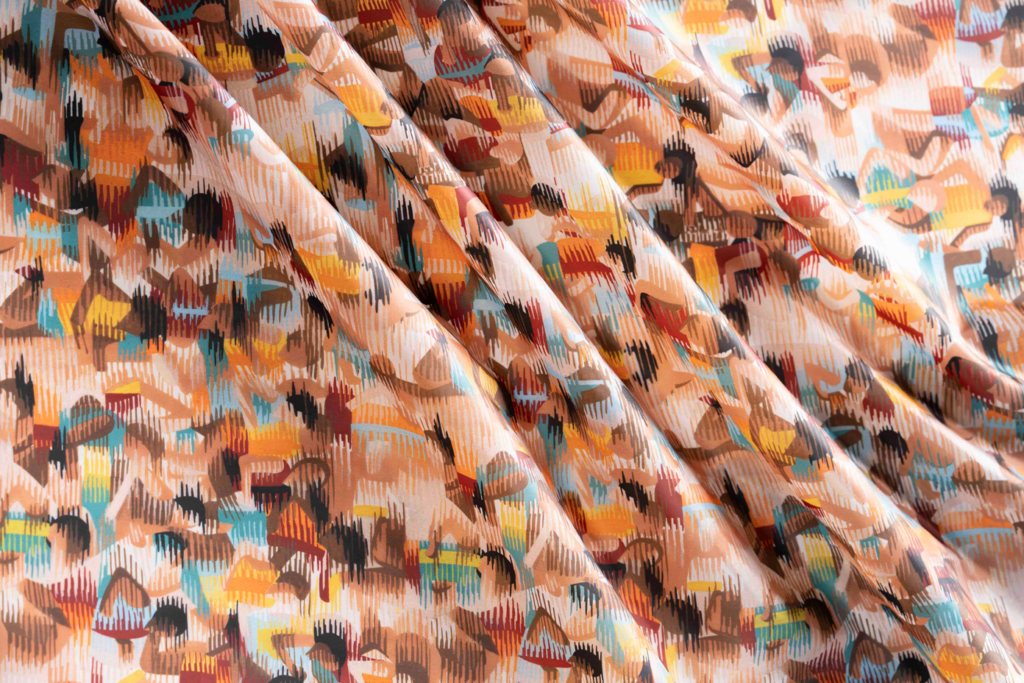10 Questions with Clerici Tessuto
We sat down with Sara Tessuto, Marketing and Communications Manager of Clerici Tessuto to learn a little bit more about the company, how its evolved and its continual commitment to sustainability.
A true icon in the world of textiles in Italy and abroad, the story of Clerici Tessuto first begins in 1922 in the heart of Como, Italy. The company defines itself with a simple phrase: “inspired by beauty. Driven by sustainable innovation.” which today serves the needs of fashion and luxury brands worldwide. As a pioneer in silk and jacquard production, Clerici Tessuto has since expanded its market offerings introducing dedicated divisions focused on women’s and men’s clothing, swimwear, and home decor through various materials, including cotton, linen, and wool.
With a close eye on sustainability, encompassing environmental, social, and ethical aspects, the company works to provide customers with products of the highest quality, produced responsibly. Fabrics that demonstrate how creativity, passion, quality, innovation, and sustainability can come together in perfect harmony to create a product that represents true beauty. Despite industry evolutions, changing market demands, and new technologies, Clerici Tessuto continues to bring beauty and quality to the forefront.
We sat down with Sara Tessuto, part of the Clerici Tessuto family and current Marketing and Communications Manager of the company to learn a little bit more about the company, how it evolved and its continual commitment to sustainability.
1.Dr. Sara Tessuto, Clerici Tessuto is undoubtedly one of the most recognized labels in the textile industry worldwide. Can you tell us a bit about its story and origins?
Last year the company celebrated its 100-year mark. It was founded on July 6, 1922, by Rachele Clerici, the wife of Alessandro Tessuto, my great-grandmother. The company’s offices were initially in Como, on Via Vittorio Emanuele, and the first production facility, which included seven looms, was located in Cadorago. The company initially focused on producing silk fabrics for women’s clothing. In 1938 Clerici Tessuto purchased the Forzano textile company building in Grandate, which still today serves as the company’s headquarters. Now, the location houses over a hundred looms and just about the same number of employees.
2.The company’s origins were in silk and jacquard production. Is this still a significant part of the company’s identity today, or have you diversified into new areas and market segments?
The company’s roots in silk production for women’s clothing remain at the core of our identity. While we’ve continually adapted to changing market demands, we’ve remained true to our origins and essence. Today, Clerici produces various collections of fabrics for both women’s and men’s clothing, as well as for accessories and home furnishings. We cater to a range of market segments, from haute couture to ready-to-wear and the mid-range market.
3.Dr. Tessuto, as your company has expanded, its most definitely had to embrace innovation and technology especially to meet increased production demands. Could you tell us about your approach to innovation and technology?
Innovation and technology play a crucial role in improving efficiency, optimizing production, and increasing productivity. These advancements are necessary to meet evolving market demands and challenging customer requirements. Technology is a valuable tool in our work and personal lives, but it has its limitations. Machines cannot replace the human touch, and I strongly believe that human expertise adds unique value. At Clerici Tessuto, we strive to meet the perfect balance between innovation and traditional craftsmanship.
4. It’s fascinating to hear about your company’s evolution and its embrace of technology. But I’m curious about how you are able to maintain the beauty of tradition and craftsmanship, which seem to be an important part of your company’s DNA.
Clerici Tessuto’s DNA is characterized by research, innovation, and excellence. The beauty of our tradition and craftsmanship is preserved in our “I Classici” collection, which includes over 200 woven fabrics. These fabrics represent the essence of Clerici Tessuto since its earliest years. In this collection, customers can find the founding silks part of the company’s history that represent how our deep experience meets extraordinary innovation in materials and finishes.
Even in the modern Clerici Tessuto collection, we keep the company’s tradition close. This collection, designed for the ready-to-wear market, combines classic fabrics with contemporary ones, featuring natural or technical yarns for a modern and contemporary feel. It offers a range of eco-sustainable fabrics without compromising on quality.
5.Dr. Tessuto, can you tell us more about what craftsmanship and tradition mean to you? Is there something special that you continue to do, which many manufacturers may have abandoned due to cost or time constraints?
What Clerici Tessuto continues to do, which many manufacturers have abandoned, is our dedication and care in producing “velluti a bacchetta” (striped velvets) and “tessuti chinè” (chine fabrics).
The company has refurbished some historical looms that allow us to weave beautiful and exceptional silk épinglé velvets, using the ancient “a bacchetta” technique. Unlike more commonly available velvets, this traditional manufacturing technique allows us to create both the cut and the pile of the velvet, resulting in a more intricate and refined effect. Today, there are only a few machines in the world capable of weaving velvets of this caliber, making the “bacchetta looms” the heart of craftsmanship at Clerici Tessuto.
Clerici Tessuto is also one of the last weaving mills in the world capable of producing traditional “chinè” fabrics. Chinè fabrics are unique textiles created with hand-printed warps and then meticulously woven on specially structured looms. A so-called “canovaccio” or warp is created, woven with a “fake” weft that appears like a net at first glance. The fabric is then manually printed, and after returned to the loom where, after removing the fake weft with a delicate manual unpicking operation, it is traditionally woven to create a more classic effect with undefined contours.
6. It’s interesting to see how the concept of “Made in Italy” continues to grow in importance, particularly among environmentally conscious consumers who seek local and transparent sourcing. Have you experienced this change in your business, and do you think brands today are willing to pay more for high-quality locally produced fabrics?
Yes, we’ve seen a significant shift in the textile industry. Younger generations are more environmentally conscious and demand information about product traceability, production processes, and materials used. Our supply chain is made up of our own individual creative and productive resources that include some of the best Italian textile partners. This approach ensures quality, reliability, and speed, allowing us to integrate our know-how across the different steps. It means a lot and sticks out to our customers, especially among younger generations who are increasingly aware of how the fashion industry impacts the environment.
7. Can you share thoughts and insights into other emerging trends among buyers today, aside from sustainability?
Certainly, sustainability has become a central focus for our company. Requests related to product traceability and transparency are on the rise. Additionally, inclusivity is an emerging trend among our younger customers. Clerici Tessuto adapts to these trends and is committed to addressing them.
8. Can you discuss innovation not only in terms of production but also in terms of digitalization? How has Clerici Tessuto embraced digitalization to enhance the company?
Digitalization is not actually such a distant concept for the textile industry or us. At Clerici, we began integrating digitalization into our production processes a few years ago, of course always with a focus on sustainability and meeting new customer demands. For example, instead of producing physical fabric samples, we now provide digital samples to reduce paper, ink, fabric, and fuel consumption, using systems also like Bsamply. Digitalization allows for reduced consumption and improved sustainability that should continue to be encouraged.
9. What does sustainability mean for Clerici Tessuto, and has it been challenging to implement, given the traditional processes you have in place?
Sustainability is a core commitment for the Clerici Tessuto Group. We prioritize environmental, social, and ethical sustainability in all aspects of our operations. Our fabrics embody the perfect blend of creativity, passion, quality, innovation, and sustainability. Our commitment to sustainability is also evident in our corporate culture, the respect and empowerment of people, environmental protection, and support for our local community. We recently released our second Sustainability Report in September 2023, which shows the transparency regarding our environmental and social sustainability efforts.
10. Could you share a specific and significant sustainability initiative that Clerici Tessuto has undertaken this year?
In January of this year, Clerici Tessuto started a pilot training project in collaboration with the Starting Work Higher Institute. Together we offered a course that concluded with a diploma in Higher Technical Education and Training (IFTS) in artisanal production techniques for Made in Italy products with a first level appreciation to the first 6 students selected for the project. The program included 800 hours of theoretical and on-the-job training, followed by mentoring in our company’s offices. All six participating students were later offered a position at Clerici Tessuto with an apprenticeship contract. We are proud of the project’s successful outcomes.


